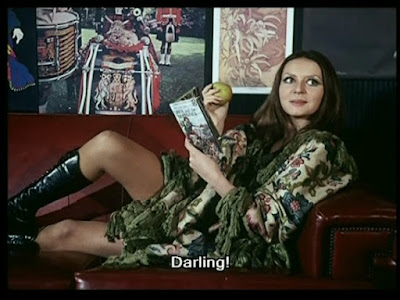An anxious man in a London hotel asks the manager for his
bags to be packed and to have a cab waiting for him at the curb. He returns to his room to find his luggage
already packed and waiting for him which, for whatever reason, greatly perturbs
him. He pays his bill, and while
attempting to enter the cab, he is killed with a precision knife throw from an
unknown assailant. Handsome Inspector
Robert Redford (Fred Williams) arrives to investigate, and the crime scene
yields little evidence. Redford hooks up
with his friends, crime novelist Charles Barton (Horst Tappert) and
photo-journalist Andy Pickwick (Luis Morris) for help. The sole lead in his case is a doctor, Dr.
Blackmead (Siegfried Schüremberg)—who happened to be in the vicinity of the
film’s first kill. At the doctor’s
office, Redford meets Dr. Blackmead’s assistant, Helen (Elisa Montés), and is
instantly smitten. Another murder occurs
with the same modus operandi, yet
there is no discernable link between the victims. Redford’s leads run cold. A mysterious man (Dan Van Hussen) breaks into
the home of Charles Barton, and is caught stealing red-handed by Barton. The would-be thief says he knows Charles
Barton, personally, and the man occupying this home and using his name is not
the same. Meanwhile, a distraught Helen
meets Redford at a bar and reveals to him that she found a dangerous opiate
among the doctor’s pharmacy. She
believes that the good doctor has too large a quantity of illegal narcotics to ignore. Redford agrees and has a break in the
case. He promises to protect Helen, who
reveals that she has a mysterious past, as well…
Franco crafts a fine krimi
film with The Death Avenger of Soho. The film is based on a novel by Bryan
Edgar Wallace [which had been previously filmed as Das Geheimnis der Schwarzen Koffer in 1963] and its screenplay is
by Franco and Artur Brauner, whose production company CCC was looking to cash
in on the popular Wallace krimi
craze. (1) Death Avenger was made towards the end of the krimi cycle. (2) There is a
moodiness to Death Avenger quite like
Sie Tӧtete in Ekstase (She Killed in Ecstasy) (1970) where
there is an overwhelming sense of uncomfortableness accompanying the dramatic
action. As there is little information
made available as to what is motivating the killings, the resultant vibe is
uneasiness and dread. Franco’s
photography (by Manuel Merino) has some exceptional set pieces. The opening alleyway, where the first murder
occurs, has a haunting quality, as a blind organ grinder listlessly chimes away
accompanies perfectly the composition: a
tight alley where a clearly audible gust of wind seemingly does not affect a
small bank of fog. Franco also makes
good use of the wide-angled lens, as he did subsequently in La Maldición de Frankenstein (1972). There is a particularly, nasty giallo-esque murder near the end of the
film. Despite the seriousness of the
dramatic action, Franco does allow The
Death Avenger to be a sexy, flirty film.
For example, when Redford meets Helen for the first time, she opens the
door and asks what he wants. Redford
coyly replies with a marriage proposal which the young lady politely
declines. It is easy to tell that these
two characters have chemistry, and the film is propelling them towards each
other; but Franco does not have to labor over a romantic subplot in order to
produce one. Unsurprisingly, Franco gets
to include a sexy, nightclub set piece.
I would be shocked to learn if Franco’s libido ever waned. Finally, The
Death Avenger of Soho is a good film, because it is character-driven with
interesting people populating the narrative (as opposed to the
paint-by-numbers, procedural-plot-driven krimi).
Perhaps my Franco bias is elevating The Death Avenger of Soho above most krimi. However, I do believe
that krimi fans, giallo fans, and Jess Franco fans will enjoy this one. The
Death Avenger of Soho is a neglected film in Franco’s filmography during a
period where he was particularly fertile.
1. Blumenstock, Peter.
Obsession: The Films of Jess Franco. Ed. Lucas Balbo & Peter Blumenstock. Graf Haufen & Frank Trebbin. Germany.
1993: p. 83.
2. Ibid.



1 comment:
A neglected film indeed and a delightfully overcomplicated one at that
Post a Comment